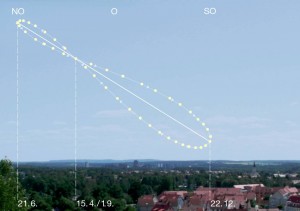Using Only a Camera, Trace the Solar Analemma and Plot the Solstice
When viewed at the same time every day for a year, the Sun traces a pattern in the sky that can help you find out when a solstice occurs
![]()

The Sun traces a figure eight pattern in the sky when viewed at the same time every day for a year. This pattern, called an analemma, allows you to know when the solstices occurred. Image courtesy Jailbird
Despite all the doomsday hype about December 21 being the last day of the Mayan long count calendar, dawn broke today and the world hasn’t ended. Though there is still day left for apocalypse to start, NASA in particular will be relieved when today turns into tomorrow–over the past few weeks, hundreds of concerned citizens have been calling the agency every day for reassurance, prompting NASA to post a video intended for release tomorrow on “Why the World Didn’t End Yesterday.”
“Dec. 21, 2012, won’t be the end of the world as we know,” NASA relates on its website, “however, it will be another winter solstice.”
Perhaps the coincidence of the solstice with the resetting of the Mayan calendar has fueled the idea that today is a mystical day. The winter solstice is the day of the year that contains the shortest amount of daylight and the longest amount of night–it marks the beginning of winter, and many cultures celebrate how it heralds longer amounts of daylight to come. But astronomically, the Northern Hemisphere’s winter solstice was the specific time of the day–6:11 a.m. Eastern, in fact–when Sun’s rays at the the Tropic of Capricorn were directly overhead. The Sun’s rays will never be directly overhead at any point south of this latitude.
Archaeological evidence supports the idea that many ancient cultures knew about the solstices–several monuments, such as the earliest known ancient astronomical observatory in Newgrange Irelend (where the rising sun today illuminated the structures inner chamber for the first time since the last winter solstice) were built in such a way as to mark solar events. But this all begs the question–how did the ancients know when the solstice would occur?
The answer may lie in the meaning of the word “solstice.” Derived from the Latin sol (Sun) and sistere (to make stand, as in to stand still), during the solsticies the Sun’s position north or south of the celestial equator (an imaginary plane that extends Earth’s equator out into space) stands still. In other words, the seasonal movement of the Sun’s path, as seen from any fixed location on Earth, reaches a low point before reversing direction.
This low point is something that given clear skies and patience, you could see for yourself. Imagine going outside at the same time of day every day for a year and taking a picture of the Sun. As the days pass, you’d notice that the position of the Sun in each picture changes with respect to the horizon. Combining all your pictures into a single image shows that the Sun’s position traces a figure eight pattern, called an analemma.Depending on the time of day and that you record your observations (a.m. or p.m.), and your latitude, the analemma will be tilted. The analemma traced at the North Pole would be fully vertical with the small loop at the top, and the one traced at the equator would be horizontal. The analemma at the South Pole would be vertical with the big loop at the top, but you would only be able to see a portion of it–the rest would be hidden by the horizon.
Why does the Sun trace this odd path? The reasons boil down to two facts. First, the Earth is titled at an angle when it rotates, and second, the Earth has an eccentric orbit–it orbits in an ellipse as it revolves around the Sun. Universe Today puts it this way: “an object with a perfectly circular orbit and no axial tilt, the Sun would always appear at the same point in the sky at the same time of day throughout the year and the analemma would be a dot, an object with a circular orbit but axial tilt similar to Earth’s, the analemma would be a figure of eight with northern and southern lobes equal in size, an object with eccentricity similar to Earth’s, but no axial tilt, the analemma would be a straight east-west line along the equator.”
Looking at the analemma you created over the course of the year, you can notice a key thing–your figure eight is symmetrical. A line of symmetry drawn through the analemma intersects the shape at two points other than where the lobes touch. The days that you recorded the Sun at those points are the solstices; the one lower in the horizon is the winter solstice and the higher one is the summer solstice. You can also notice that the point on the analemma closest to the horizon–marking the latest sunrise or sunset, depending on whether you made your analemma in the morning or evening–was not recorded on the day of the solstice.
The ancients didn’t have cameras, so their calculations of the solstice may have involved how the shadow of a stick planted in the ground, when measured at the same time every day, traces a similar analemma to what you can document with your camera. In fact, the Mayans were adept at using shadows to mark the equinoxes and solstices.
The solar analemma may have been a powerful tool to tell the ancients that longer days were about to begin. The same can be said for us–all we need to do is make it past midnight today!
.
/https://tf-cmsv2-smithsonianmag-media.s3.amazonaws.com/accounts/headshot/mohi-kumar-240.jpg)
/https://tf-cmsv2-smithsonianmag-media.s3.amazonaws.com/accounts/headshot/mohi-kumar-240.jpg)